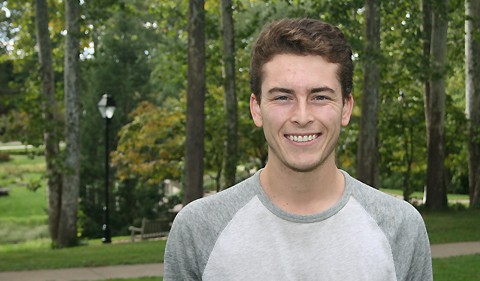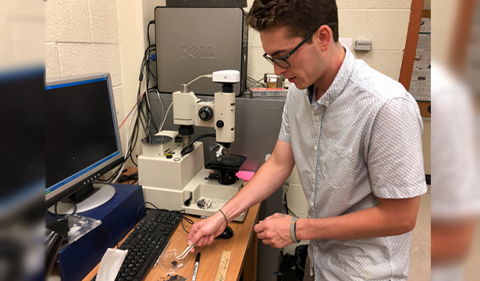By Rush Deeter
(B.S. Physics, College of Arts & Sciences, Class of 2019)
Editor’s Note: Rush Deeter worked with Dr. Eric Stinaff on a project to exfoliate various two-dimensional materials such as molybdenum disulphide and tungsten diselenide onto lithographically patterned substrates for single photon applications. He used silicon/silicon dioxide substrates to create patterns to locate and enhance the quantum emission properties.
During my internship, I performed photolithography and mechanical exfoliation. I used silicon dioxide substrates and etched patterns into them using photolithography. Once I had obtained an adequate pattern, I would perform mechanical exfoliation of molybdenum disulfide and place it onto this pattern with the goal of later using it to create mono-to-few layer structures.
Although mechanical exfoliation sounds very straightforward, there are many intricacies and difficulties while performing it. The process involves taking a small amount of material (usually less than 1 mm by 1 mm), placing it on a specific type of tape, and then sticking pieces of tape together with the goal of achieving mono or bi-layers of this material.
During the summer of 2017, I learned how to perform photolithography from undergraduate Miles Lindquist, a former student intern under Dr. Stinaff. This skill was used for a different purpose last year but knowing how to do it this year made performing photolithography feel like second nature, and thus, increasing my productivity. Last year I had about a 70% success rate and this year I would say it is closer to 85 or 90%. I also was able to improve my overall lab skills including things such as how specifically my notes were taken and how meticulous I was when carrying out each trial of the experiment.
One challenge that I overcame during this was how to balance my time efficiently working in the lab, doing research outside of the lab, and keeping up with the foreign language that I was learning. Over the summer, I also took two Spanish courses, which proved to take up more of my time than expected. I had class from around nine in the morning until eleven and then I would go home, eat lunch, and head to work to get my hours in. After that I would go home, do my Spanish homework, and sometimes read a paper related to my research. Doing all of this kept me busy but also helped instill valuable time management skills.
Because I worked in a hands-on lab environment almost all of my discussions with Dr. Stinaff were face to face and averaged two meetings a week. There were some weeks where I would be in and out of his office multiple times asking questions or clarifying how to do something, and there were others where I just needed a quick question one day and had enough guidance already to carry out my experiments for the week. I continued this research during the fall semester.
What intrigues me about my research topic is not only how it could be applied to the real world, but also how amazing it is that we have the technology to be able to work at such insanely small scales. Before my research experience last summer, I did not even know that we know the size of an atom, or that we have found a way to extract single layers of atoms from a material.





















Comments